Abstract
The effect of pH and temperature on the interaction of sodium citrate-coated magnetic iron oxide nanoparticles (IONPs) with the BSA protein was studied using optical methods. The optical properties of aqueous colloids of BSA, IONPs, and BSA with IONPs were studied with pH changes in the range of 2–12 and temperature in the range of 25–85 °C. It was found that at pH 2.0, no significant changes in the optical properties were observed with increasing temperature in aqueous colloids containing a mixture of BSA with IONPs. Temperature affects the optical properties of BSA colloids with IONPs in the pH range from 5.0 to 8.0. Moreover, by increasing the temperature at these pH levels, it is possible to control the particle size in the colloids. In general, both temperature and pH have a significant effect on the properties of the aqueous colloid of BSA with IONPs and allow for the control of interactions between BSA and IONPs, namely, the processes of aggregation, particle reclustering, and protein denaturation.
1. Introduction
Currently, there is a growing interest in the use of iron oxide nanoparticles in biomedicine and agriculture as biosensors [1], gene/drug carriers [2,3], therapeutic agents [4], contrast agents [5], growth stimulants [6], fertilizers [7], antibacterial agents [8], etc. [9,10,11,12,13,14,15]. In the field of biomedicine, iron oxide nanoparticles are highly functional and biocompatible nanostructures with magnetic properties [16]. Iron oxide nanoparticles interact with a magnetic field; this quality allows them to be moved inside bioobjects when using a constant magnetic field, and to cause local tissue heating when using an alternating external magnetic field, which is convenient for both monitoring and therapy [17]. The use of iron oxide nanoparticles as contrast agents shows great promise in both scientific research and clinical applications [18]. Coated iron oxide nanoparticles are superior to commercial gadolinium-based agents as a T1 contrast agent for low-field magnetic resonance imaging [19]. Magnetic delivery of nanoparticles is used to control drug release and improve treatment efficacy [20]. Thus, iron oxide nanoparticles conjugated with doxorubicin are effective against breast cancer cells [21]. Small iron nanoparticles have been shown to reduce the amount of MtDNA in colorectal tumor cells [22]. In agriculture, iron oxide nanoparticles can be used to reduce stress in soft wheat (Triticum aestivum) caused by chromium ions [23]. There are studies on the use of iron nanoparticles to improve salt tolerance in capsicum seedlings (Capsicum annuum) and other plants [24]. The combined use of silicon and iron nanoparticles reduces the harmful effects of Pb ions on rice plants more effectively than the use of either type of nanoparticle separately [25]. Most of the aforementioned articles report interactions between iron oxide nanoparticles and cellular and tissue components, particularly protein molecules [26]. Currently, researchers are particularly interested in the interactions of nanoparticles not only with native proteins, but also with proteins that have undergone changes in their native conformation. Protein adsorption on nanoparticles can change the state of aggregation, interfacial composition, and electrical charge of the nanoparticles, thereby influencing their subsequent interactions with the environment [27,28]. Exposure to external conditions (alkaline or acidic environment, temperature, ionic strength of solution) can provide such changes [29,30,31]. Under normal conditions, changes in the native conformation of a protein can occur under much less extreme conditions, for example, as a result of “aging” of the protein molecule [32]. Such changes are often accompanied by aggregation of molecules, and even the formation of amyloid-like structures [33]. The interaction of proteins and nanoparticles can lead to both stabilization of the particle structure and, conversely, even greater deformation. In [34], it was shown that by changing the pH of the medium, it is possible to control the state of lipid nanoparticles coated with BSA. The BSA protein consists of three domains that can independently rearrange relative to each other. Currently, only 5 isomeric forms of BSA are known that can make reversible transitions between themselves (pH 2.7 (E), pH 4.3 (F), pH 8.0 (N), pH 10.0 (B) and (A)) [35]. Another important factor affecting the state of proteins and the physical parameters of interaction is temperature [36]. An increase in temperature above 60–65 °C can cause irreversible changes in the protein conformation; it is assumed that interaction with nanoparticles under various external conditions can stabilize the protein conformation. In general, there may be other scenarios of interaction between proteins and nanoparticles. Sometimes, adsorption of proteins on the surface of nanoparticles may be observed. Protein molecules form a layer on the nanoparticle, a “protein corona”, which may affect the adsorption, accumulation, degradation, and purification of nanoparticles [37]. It is known that the protein corona may consist of two parts: an internal ordered layer firmly fixed on the surface of nanoparticles and a more mobile external layer with a looser structure [38]. Sometimes, when interacting with the surface of nanoparticles, conformational changes in the protein molecule may be observed, which may affect the functionality of proteins. Sometimes, when proteins and nanoparticles come into contact, fibrils may be formed. Nanoparticles may induce structural changes in proteins, which lead to polymerization [39]. It is assumed that temperature and pH may significantly affect the development of events according to one or another scenario. The aim of this work is to study the influence of external factors such as pH and temperature on the interaction of BSA protein with magnetic iron oxide nanoparticles in an aqueous colloidal solution using optical non-invasive methods.
2. Materials and Methods
2.1. Preparation of Colloidal Solution of Ions Nanoparticles
Iron oxide nanoparticles coated with sodium citrate were obtained by chemical precipitation from an aqueous solution of a mixture of trivalent and divalent iron chloride salts. The preparation method was described in detail in previous publications [40,41]. The concentration of the obtained particles was 1016 particles/mL. In the experiments, particles with a final concentration of 5 × 1012 particles/mL were used by diluting the initially obtained nanoparticles with deionized water (resistance 18.0 MΩ × cm) or BSA colloid. The concentration of nanoparticles in the colloidal solution was determined using a Zetasizer Ultra Red Label. The main properties of the nanoparticles are shown in Table 1.

Table 1.
Properties of nanoparticles used in experiments.
2.2. Preparation of Colloidal BSA Solutions
To prepare the colloidal protein solution, lyophilized BSA powder (Sigma-Aldrich, A7906, St. Louis, MO, USA) was dissolved in deionized water. The pH of the solution was 7.0 at a final concentration of 0.5 mg/mL used in all experiments (5 × 1015 particles/mL). When mixing a colloidal solution of BSA with nanoparticles, the number of particles ratio was 1000 to 1 (mass ratio 40 to 1), respectively. It is known that BSA is stable in aqueous solutions, and the effect of ionic strength on these solutions is insignificant [42]. Therefore, for the convenience of changing the pH of the solution, deionized water was used instead of buffer solution.
2.3. pH Measurement
pH values were measured using a Seven Excellence S470 precision station (Mettler Toledo, Greisensee, Switzerland) in 5 mL vials with constant stirring using a magnetic stirrer with a Teflon stirrer in close-to-laminar mode. The pH of the solution was changed by adding different amounts of HCl 0.1 or 1 M (to acidify the medium) or NaOH 0.05 or 1 M (to alkalize the medium). Acid and alkali were added dropwise in volumes of 2–3 μL.
2.4. TEM-Microscopy
Transmission electron microscopy was performed using a Libra 200 Fe HR (Carl Zeiss AG, Oberkochen, Germany). Samples of 0.25 μL were applied to a gold grid with a titanium holder. The samples were dried at room temperature for 10 min and evacuated. It is shown that during the drying process the nanoparticles form rather large aggregates, which is quite typical for superparamagnetic nanoparticles (Figure 1). The characteristic size of one nanoparticle in aggregates is about 3–10 nm.
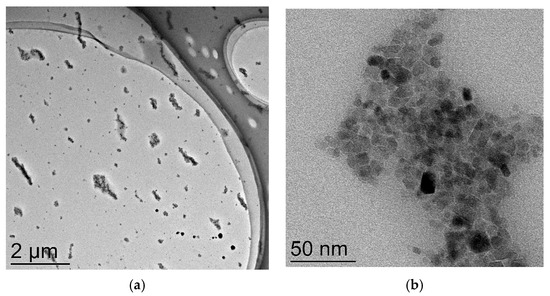
Figure 1.
TEM images of IONPs nanoparticles: (a) low magnification, large clusters of nanoparticles are visible, (b) high resolution, individual nanoparticles are visible.
2.5. Temperature Control
Temperature effects were carried out using a Laznia Wodna LW-4 water thermostat (Poland) in 5 mL vials. Temperature control was carried out using a mercury thermometer and an Aktakom ATT-2002 thermometer with a platinum electrode. Temperature effects were carried out at 25, 45, 65, 85 °C. The maximum temperature of 85 °C was chosen because most proteins partially or completely denature under this effect. Intervals of 20 °C are optimal, since the number of selected temperature points is sufficient to track the dynamics of changes in interactions between proteins and nanoparticles. At a temperature of less than 25 °C, proteins practically do not change their native conformation. The exposure time was 30 min. The accuracy of temperature maintenance and control is ±1 °C.
2.6. Dynamic Light Scattering
Dynamic light scattering is a method for determining the average hydrodynamic diameter of particles in liquid [43]. The measurements were performed using a Zetasizer ULTRA Red Label (Malvern Panalytical Ltd., Malvern, UK). The scattered light was measured at an angle of 174.7°. The intensity distributions by size were calculated using ZS Xplorer software. The measurements were performed in thermostat mode at temperatures of 25, 45, 65, and 85 °C. Three independent measurements were made for each test solution. A total of 1 mL of the test sample was used in each measurement.
2.7. Absorption Spectroscopy
Absorption spectra were measured on a Cintra 4040 spectrophotometer (GBC Scientific Equipment, Keysborough, Australia) in quartz cuvettes with an optical path length of 1 cm. Absorption spectra were measured three times for each sample in the range of 200–700 nm at a scan rate of 960 nm/min and a slit width of 2 nm.
2.8. Measurement of ζ-Potential
Measurements of the electrokinetic potential were carried out using a Malvern Zetasizer Ultra (Malvern Panalytical Ltd., Malvern, UK) at 25, 45, and 65 °C. At higher temperatures, it is impossible to measure the electrokinetic potential under our conditions. The obtained data were processed using the ZS Xplorer software v1.30. All measurements were performed automatically with a measurement repetition range of 10 to 100. Each sample was measured 3 times, with a 60 s pause between repetitions. The temperature equilibration time before each measurement was 60 s.
2.9. Refractometry
The refractive index measurements were performed using an Abbemat MW multiwave refractometer (Anton Paar, Graz, Austria). For the experiments, 1 mL of the solution was placed in the device cell, and measurements were taken at a wavelength of 632.8 nm at a temperature of 25 °C. Resolution: RI ± 0.000001 nD; temperature 0.01 °C. Accuracy: RI ± 0.00004 nD; temperature ± 0.03 °C; temperature stability ± 0.002 °C.
2.10. Fluorescence Spectroscopy
Fluorescence in aqueous BSA solutions was studied using a Jasco FP-8300 spectrometer (JASCO Applied Sciences, Victoria, BC, Canada). Measurements were performed in a quartz cuvette with an optical path length of 10 mm. The sample volume was 2 mL. Each sample was measured three times. Two-dimensional fluorescence spectra were recorded. Fluorescence excitation for all samples was performed at a wavelength of 278 nm, and fluorescence emission of the samples was recorded in the range of 295–450 nm; the scanning speed was 1000 nm/min.
3. Results
The dynamic light scattering method was used to detect changes in particle size with changes in pH and temperature in a colloidal solution. Before starting the measurements, we also made sure that the BSA protein and iron oxide nanoparticles are able to interact. The task was performed using the Malvern Zetasizer instrument with the measurement of BSA concentrations without nanoparticles and with the addition of nanoparticles (Appendix A.1).
The dependence of the IONPs nanoparticles' size distribution on temperature at pH 2–12 of aqueous colloidal solutions was studied (Figure 2). At pH 2.0, IONPs aggregated to micron sizes, and the aggregates size did not depend on temperature (Figure 2a). Indeed, a significant change in the size of nanoparticles depending on the pH of the medium was shown earlier [44,45]. With an increase in pH to 5.0, clusters of micron-sized nanoparticles are no longer observed in the colloidal solution (Figure 2b). Reclustering occurs, and two types of nanoparticle clusters with sizes of 10–25 nm and 50–200 nm are observed in the colloidal solution at a temperature of 25 °C. With an increase in temperature to 85 °C, the average hydrodynamic diameter of small particles decreases to 7 nm, and the formation of particles with sizes of 25–50 nm is observed. With an increase in the colloid pH to 8.0, particles with sizes of 8–50 nm and 80–300 nm are present in the solution (Figure 2c). With increasing temperature to 85 °C, the average particle size decreases, and the ratio of small-to-large nanoparticle clusters changes. If at 25 °C there are 1.5 × 104 small particles per 1 large particle, then at 85 °C the ratio increases by another 20%. At a highly alkaline pH of 12.0 (Figure 2d), with an increase in temperature from 25 °C to 85 °C, an increase in particle size from 10–80 nm to 600–900 nm is observed. Thus, an increase in temperature at highly alkaline pH stimulates the formation of large IONPs aggregates. In this case, unlike at pH 2.0, the aggregation process can be controlled by gradually increasing the temperature.
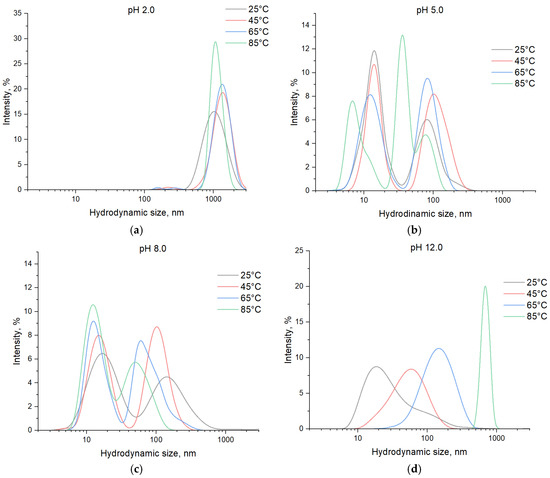
Figure 2.
Dependence of the distribution of IONPs particles by size in aqueous colloids on temperature at pH: (a) 2.0, (b) 5.0, (c) 8.0, (d) 12.0.
Thus, at room temperatures, the nanoparticles used in the experiments are stable at pH 5.0 and above. At pH 5.0–8.0, per million nanoparticles with a hydrodynamic diameter of about 10 nm, there is one aggregate with a hydrodynamic diameter 10 times greater, and with increasing temperature, the average hydrodynamic diameter decreases slightly. Under alkaline conditions at pH 12.0, the distribution of nanoparticles by size is monomodal, and the hydrodynamic diameter gradually increases by 2 orders of magnitude with an increase in temperature from 25 °C to 85 °C.
Figure 3 shows the effect of temperature in the range of 25–85 °C and pH in the range of 2.0–12.0 on the size distribution of BSA molecules and their aggregates in aqueous colloids. At a strongly acidic pH of 2.0 (Figure 3a) and temperatures of 25–45 °C, the colloid contains individual BSA molecules and aggregates consisting of small number of BSA molecules with sizes of 10–30 nm, as well as an insignificant number of aggregates with sizes of 80–200 nm (1 aggregate per 3 × 106 individual molecules). With an increase in temperature to 65 °C, the number of aggregates in the colloid increases slightly. With an increase in temperature to 85 °C, the number of individual BSA molecules increases, aggregates consisting of a small number of BSA molecules practically disappear, and the number of aggregates in the colloid also decreases sharply.
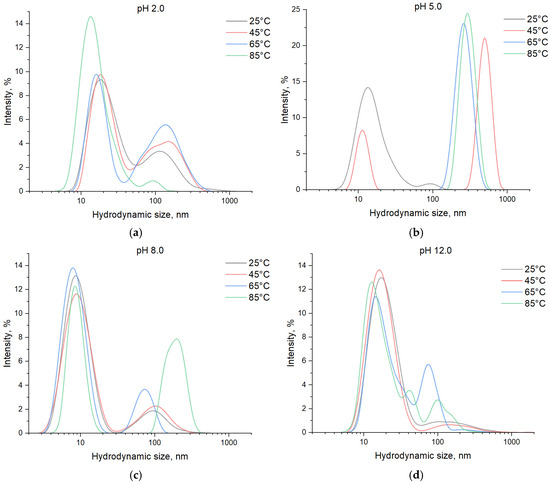
Figure 3.
Dependence of the distribution of molecules and aggregates of BSA by size in aqueous colloids on temperature at pH (a) 2.0, (b) 5.0, (c) 8.0, (d) 12.0.
At pH 5.0, with increasing temperature, all individual molecules aggregate (Figure 3b). With an increase in temperature from 25 °C to 45 °C, the number of individual BSA molecules and aggregates consisting of a small number of BSA molecules in the aqueous colloid decreases by almost half. At a temperature of 65 °C, no individual BSA molecules remain in the colloid; only aggregates are observed. With an increase in pH to 8.0 (Figure 3c), individual BSA molecules are observed in the colloid, and the average hydrodynamic diameter of the protein globules is 8 nm. An insignificant content of aggregates with an average size of about 50–200 nm is also detected. With an increase in temperature, the number of aggregates increases more than 3 times. With an increase in pH to 12.0, the size of the BSA protein globule increases, and both individual BSA molecules and aggregates consisting of a small number of protein particles are observed in the colloid (Figure 3d). With an increase in temperature to 65 °C, an increase in the contribution to light scattering of individual BSA molecules is observed, while the contribution of aggregates consisting of a small number of BSA molecules decreases. With an increase in temperature to 85 °C, the process becomes even more pronounced; the average value of the hydrodynamic diameter is 13 nm, for comparison, at 25 °C—18 nm. In this case, the number of aggregates with sizes of about 100 nm increases significantly with an increase in temperature.
Thus, the greatest number of individual BSA particles is observed in the aqueous colloid at pH 8.0. At all other pH values studied, both individual BSA molecules and aggregates consisting of small number of BSA molecules are observed. Aggregates with sizes greater than 100 nm are present at all pH values studied. With increasing temperature, the number of such aggregates increases at a pH greater than 5.0.
In a separate series of experiments, nanoparticles were shown to interact with proteins (Appendix A.1). After mixing the colloidal solutions of BSA and IONPs, we performed a pH and temperature change. The particle size distributions in an aqueous colloid containing both BSA molecules and iron oxide nanoparticles are shown in Figure 4. When IONPs are added to the BSA colloid at pH 2.0, the formation of micrometer-sized aggregates is no longer observed, as in the case of IONPs. Two light scattering maxima are observed in the colloid regardless of the temperature. The first maximum corresponds to light scatterer sizes of about 20 nm, and the second to sizes of about 100 nm (Figure 4a). Change in temperature affects the intensity ratio of these two maxima, with a tendency for both maxima to shift toward smaller sizes. At pH 5.0, an increase in temperature causes a gradual increase in the light scatterer sizes: 25 nm at 25 °C; 100 nm at 45 °C; 1 μm at 65 °C; 1.5–2.0 μm at 85 °C (Figure 4b). At pH 8.0, the colloid mainly contains particles with average sizes from 13 to 40 nm (Figure 4c). With increasing temperature, the size distribution of nanoparticles shifts towards larger sizes: 13 nm at 25 °C; 18 nm at 45 °C; 25 nm at 65 °C; 40 nm at 85 °C. Additionally, with increasing temperature, the half-width of the size distribution of light diffusers taken at half-height increases. At pH 12.0, groups of light diffusers with sizes of 20–30 nm and about 100 nm are observed (Figure 4d). A change in temperature affects the intensity ratio of these two groups of light diffusers. Thus, temperature affects the size of light diffusers in the pH range from 5.0 to 8.0. Moreover, the strength of the effect of temperature on the size of light diffusers at pH 5.0 is significantly greater than at pH 8.0.
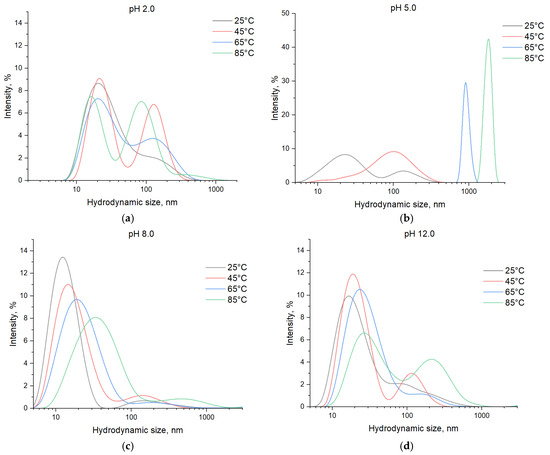
Figure 4.
Particle size distribution in an aqueous colloid containing both BSA molecules and iron oxide nanoparticles, depending on temperature at different pH values: (a) 2.0, (b) 5.0, (c) 8.0, (d) 12.0.
Measurements of the electrokinetic potential in colloidal solutions make it possible to determine the total charge in the system and contribute to a better understanding of the processes occurring in colloidal solutions. Table 2 shows the values of electrokinetic potential of nanoparticles in aqueous colloids IONPs, BSA, IONPs, and BSA at pH 2.0–12.0 and temperature 25 °C. Under conditions of medium acidity of 2.0, IONPs form large aggregates. This process can be associated with a change in the electrokinetic potential on the particles from strongly negative −27.8 mV to a value tending to neutral, −6.4 mV, at colloid pH of 2.0. It was shown in [46,47] that particles in a colloid are unstable at electrokinetic potential values close to the isoelectric point. Further increase in temperature does not lead to the destruction of the formed aggregates (Figure A2b). It was shown in [48,49] that an increase in temperature reduces the energy barrier of particle interaction and leads to the formation of large aggregates. However, on the other hand, an increase in temperature can increase the repulsion between particles due to enhanced Brownian motion of water molecules [50]. At pH 5.0–12.0, the value of electrokinetic potential of iron oxide nanoparticles is negative, in the range from −23 to −35 mV. In the case of IONPs at pH 12.0 and 25 °C, the average hydrodynamic diameter of the particles was about 18 nm. With increasing temperature, the particle size increases to 650 nm at 85 °C. At the same time, increase in the zeta potential for stable negatively charged IONPs is not observed (at 25 °C −35.6 mV, at 65 °C −45.0 mV). However, an increase in the zeta potential is expected, since aggregates are formed. Probably, with increasing temperature, stable aggregates of particles in colloidal solution begin to break down and reclustering occurs with the formation of larger aggregates.

Table 2.
Dependence of electrokinetic potential in aqueous colloids of BSA, IONPs and BSA with IONPs on pH at a temperature of 25 °C.
The electrokinetic potential of BSA molecules in aqueous colloid at pH 2.0 has a value of +8.0 mV. The isoelectric point of the BSA protein is reached at a pH of about 4.9 [51], and at a pH of 5, the zeta potential is −2.7 mV. At pH value 5.0 and temperatures of 25–45 °C, the almost neutral charge on the protein macromolecule is not sufficient for the formation of aggregates (Figure 3b). Increasing the temperature to 65–85 °C stimulates the formation of aggregates, and the formation of large particles with a hydrodynamic diameter of about 300 nm is observed (Figure A2a). The significant effect of temperature on the BSA aggregation process at pH 5.0 can be associated with an increase in hydrophobic groups in the solution volume at the isoelectric point and an increase in their interaction. At alkaline pH 8.0–12.0, the electrokinetic potential of BSA molecules becomes strongly negative, less than −20 mV.
In a colloid containing both BSA and IONPs at pH 2.0, the particles acquire a positive zeta potential of +24 mV. At pH 5.0–12.0, the charge of the colloidal particles is negative from −8.4 to −33.0 mV. The addition of IONPs lowers the temperature threshold for particle aggregation at pH 5.0, namely, 100 nm aggregates are observed already at 45 °C. In this case, the colloidal solutions have similar zeta potentials at 45 °C (BSA −2.7 mV and BSA with IONPs −5.4 mV), but the values of the average hydrodynamic diameter differ greatly (Figure A2a,c).
The change in the optical density of aqueous IONPs colloids as a function of temperature was studied at pH values ranging from 2 to 12 (Figure 5). At pH 2.0, the optical density of aqueous IONPs colloids changes insignificantly with temperatures ranging from 25 to 85 °C (Figure 5a). At pH 5.0, the optical density of aqueous IONPs colloids changes insignificantly with temperatures ranging from 25 to 65 °C (Figure 5b). At 85 °C, the optical density decreases in the wavelength range of 325–475 nm relative to 65 °C. At pH 8.0, the optical density of aqueous IONPs colloids changes insignificantly with temperatures ranging from 25 to 85 °C (Figure 5c). At pH 12.0, the optical density of aqueous IONPs colloids changes insignificantly with temperatures ranging from 25 to 65 °C (Figure 5c). At a temperature of 85 °C, a significant decrease in the optical density in the region of 230–330 nm and an increase in the optical density in the region of 400–500 nm are observed (Figure 5d). With a change in pH, there is an insignificant change in the shape of the spectra, in particular, a change in the position of the inflection points. At pH 2.0, inflections on the curves are observed at 275, 283, 310 and 362 nm. At pH 5.0, only one inflection is observed at 310 nm. At pH 8.0, inflections on the curves are observed at 275 and 310 nm. At pH 12.0, inflections on the curves are observed at 275 and 310 nm. Thus, at all pH values, the spectrum has an inflection at 275 nm. A change in the shape of the spectrum at constant pH values is observed only at a temperature of 85 °C.
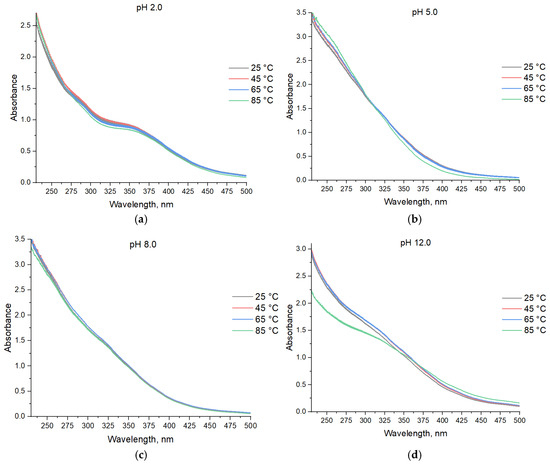
Figure 5.
Change in optical density of aqueous colloids IONPs depending on temperature at pH (a) 2.0, (b) 5.0, (c) 8.0, (d) 12.0.
Changes in optical density in solution allow studying the processes of particle and protein aggregation in solutions [52]. The change in the optical density of aqueous BSA colloids depending on the temperature was studied at pH from 2 to 12 (Figure 6). In colloidal BSA solution at pH 2.0 and a temperature of 25 °C, the absorption maximum is located at a wavelength of 275 nm. With an increase in temperature, the maximum value shifts slightly to the short-wave region, to 273 nm at 85 °C. At the same time, the intensity of the absorption maximum with a change in temperature from 25 to 85 °C increases by about 10% (Figure 6a). At pH 5.0, the absorption maximum is located close to 275 nm, and the optical density values increase from 0.3 to 3.0 with an increase in temperature from 25 to 85 °C (Figure 6b). With an increase in pH to 8.0 in aqueous BSA colloids, no effect of temperature on the nature of optical absorption is observed (Figure 6c). In other words, an increase in temperature does not affect the optical density of the colloid at pH 8.0. At pH 12.0, an increase in temperature from 25 to 85 °C, on the one hand, leads to an increase in the optical density of the BSA colloid by almost 0.1 units, on the other hand, to shift in the wavelength of the absorption maximum from 276 to 290 nm (Figure 6d). Thus, when the temperature changes from 25 to 85 °C at pH 5.0, significant change in the optical density of the colloid is observed; at pH 2.0 and 12.0, the optical density of the colloid changes little, while shift in the absorption maximum is observed; at pH 8.0, no significant changes in the absorption spectrum are observed.
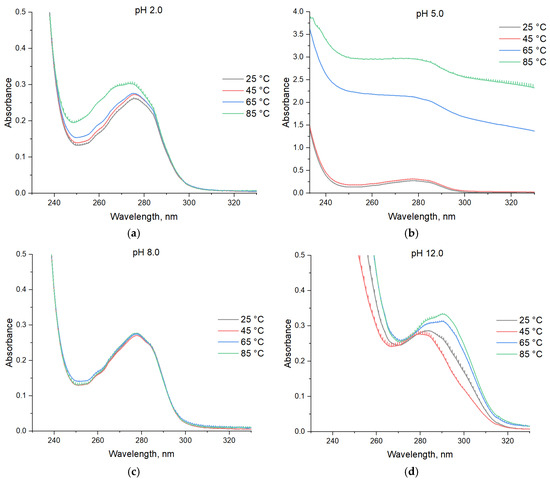
Figure 6.
Change in optical density of aqueous BSA colloids depending on temperature at pH (a) 2.0, (b) 5.0, (c) 8.0, (d) 12.0.
The change in the optical density of aqueous colloids containing both BSA molecules and iron oxide nanoparticles was studied as a function of temperature at pH from 2 to 12 (Figure 7). At pH 2.0, the absorption maximum of the aqueous colloid at temperatures of 25–65 °C corresponds to a wavelength of 279 nm (Figure 7a). With an increase in temperature to 85 °C, it shifts to 276 nm, and an increase in optical density by about 0.05 is observed. At pH 5.0, during heating from 25 to 85 °C, the position of the absorption maximum shifts from 278 nm to 284 nm (Figure 7b). In this case, a noticeable increase in optical density from 0.3 to 3.0 occurs. A slight decrease in optical density at 85 °C compared to 65 °C is due to partial precipitation of protein aggregates with nanoparticles. At pH 8.0, during heating from 25 to 85 °C, the position of the absorption maximum does not change, but an increase in optical density by 0.05 units is observed (Figure 7c). At pH 12.0 at a temperature of 25–65 °C, the absorption maximum corresponds to a wavelength of 284 nm. With an increase in temperature to 85 °C, the absorption maximum shifts to 291 nm and an increase in optical density by 0.1 units is observed. Thus, when the temperature changes from 25 to 85 °C at pH 5.0, significant change in the optical density of the colloid containing both protein molecules and iron oxide nanoparticles is observed; at pH 2.0, 8.0 and 12.0, the optical density of the colloid changes little, while changes in the position of the absorption maximum are often observed.
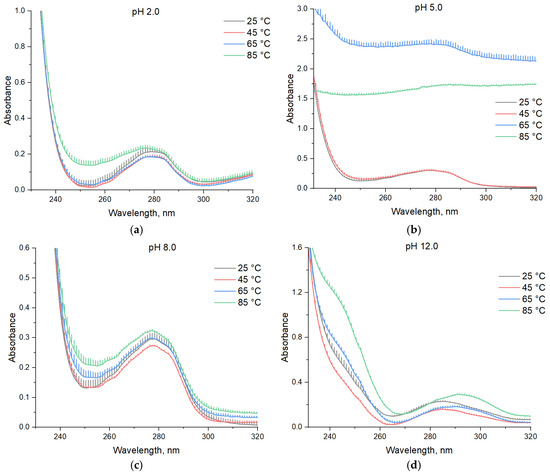
Figure 7.
Change in the optical density of aqueous colloids containing both BSA molecules and iron oxide nanoparticles, depending on temperature at pH (a) 2.0, (b) 5.0, (c) 8.0, (d) 12.0.
A change in the refractive index may indicate changes in the hydrate shell of the protein [53]. The change in the refractive index at a wavelength of 632.8 nm was studied in colloids containing only IONPs, only BSA molecules, and both BSA and IONPs molecules, with a change in temperature from 25 to 85 °C and pH from 2.0 to 12.0 (Figure 8). At pH 2.0, for aqueous colloid of IONPs (Figure 8a), an increase in the refractive index from 1.33137 to 1.33141 is observed with an increase in temperature from 25 to 85 °C. At other pH values, temperature does not significantly affect the refractive index values of IONPs colloids. At pH 2.0, in a colloid containing only BSA molecules, with an increase in temperature from 25 to 85 °C, the refractive index value decreases by 10−5 units (Figure 8b). With an increase in pH to 5.0, inversion is observed. With an increase in temperature from 25 to 85 °C, the refractive index value increases by 10−5 units. At pH 8.0, the refractive index value increases only at a temperature of 85 °C by 5 × 10−5 units. At pH 12.0, no dependence of the refractive index on temperature is observed. At pH 2.0 and 8.0, in aqueous colloid containing both BSA molecules and iron oxide nanoparticles, with an increase in temperature from 25 to 85 °C, the refractive index value does not change significantly (Figure 8c). At pH 5.0, in aqueous colloid containing both BSA molecules and iron oxide nanoparticles, with an increase in temperature from 25 to 85 °C, a decrease in the refractive index value by 10−4 units is observed. At pH 12.0, in aqueous colloid containing both BSA molecules and iron oxide nanoparticles, an increase in the refractive index by 5 × 10−5 units is observed with an increase in temperature from 25 to 85 °C. Thus, with a change in temperature from 25 to 85 °C at pH 8.0, no significant changes in the refractive index are observed. In the protein-nanoparticle system, the most pronounced changes in the refractive index are observed (up to 10−4 units) that do not correlate with changes in colloids containing only protein molecules or nanoparticles.
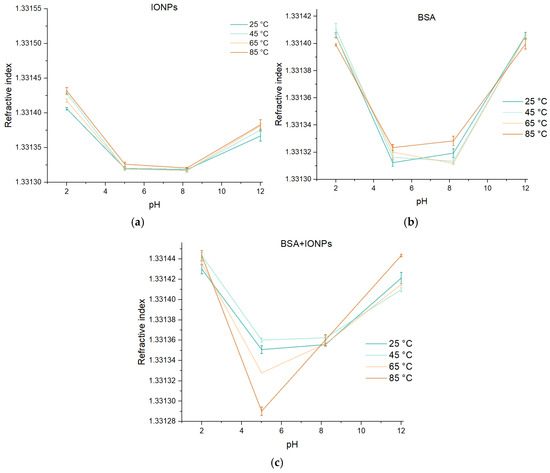
Figure 8.
Change in the refractive index at a wavelength of 632.8 nm in colloids containing only IONPs (a); only BSA molecules (b); BSA molecules and IONPs simultaneously (c), with change in temperature from 25 to 85 °C.
Fluorescence spectroscopy is an excellent tool for characterizing the state of fluorophores in a protein. Shifts in emission maxima are often associated with changes in the polarity of the microenvironment around the amino acids tryptophan, tyrosine, and phenylalanine [54,55]. Preliminary experiments showed that iron oxide nanoparticles do not exhibit pronounced fluorescence in the “blue” part of the spectrum. In this regard, the fluorescence spectroscopy method was used to study the change in the fluorescence intensity of aqueous colloids containing only BSA molecules, as well as simultaneously BSA molecules and iron oxide nanoparticles, depending on the temperature at pH from 2 to 12 (Figure 9). At pH 2.0 in colloidal BSA solution, the position of the fluorescence intensity maximum does not change significantly with increasing temperature and is 325–327 nm (Figure 9a). The fluorescence intensity decreases with increasing temperature from 25 to 85 °C by approximately 20% (from ~2500 to ~2000 rel. units). When iron oxide nanoparticles are added to a colloid with BSA molecules, the position of the fluorescence intensity maximum changes slightly (322–324 nm), and no effect of temperature on the position of the maximum is observed. The fluorescence intensity decreases with an increase in temperature from 25 to 85 °C by approximately 30%. In absolute values, the fluorescence intensity decreases by more than 4 times when iron oxide nanoparticles are added to the BSA colloid.
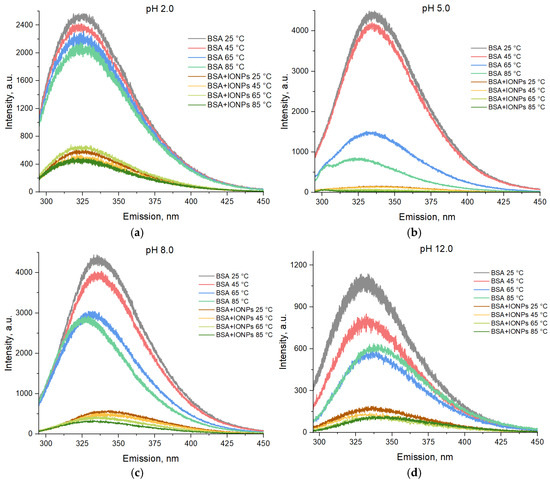
Figure 9.
Changes in the fluorescence spectrum of aqueous colloids containing (1). BSA molecules only and (2). BSA molecules with iron oxide nanoparticles, depending on temperature at pH (a) 2.0, (b) 5.0, (c) 8.0, (d) 12.0.
The maximum fluorescence intensity (~4500 rel. units) of the BSA colloid is observed at 25 °C and pH 5.0 at 336 nm (Figure 9b). With increasing temperature, the tendency for the fluorescence maximum position to shift to the short-wave region is observed; at 85 °C, the maximum is already at 325 nm. The fluorescence intensity decreases with increasing temperature from 25 to 85 °C by approximately 6.5 times. At temperatures of 25 and 45 °C, the addition of BSA nanoparticles to the aqueous colloid leads to a change in the fluorescence intensity maximum (339 nm). In absolute values, the fluorescence intensity decreases by more than 20 times upon the addition of iron oxide nanoparticles to the BSA colloid. At temperatures of 65–85 °C, no intense fluorescence was observed in colloid samples containing both BSA and IONPs.
The fluorescence intensity of about 4500 rel. units of the BSA colloid was observed at 25 °C and pH 8.0, also at 336 nm (Figure 9c). With increasing temperature, a tendency was observed for the fluorescence maximum to shift to the short-wave region; at 85 °C, the maximum was already at 328 nm. The fluorescence intensity decreased by about 35% with increasing temperature from 25 to 85 °C. At temperature of 25 °C and pH 8.0, the addition of iron oxide nanoparticles to the colloid with BSA molecules leads to change in the position of the maximum fluorescence intensity of 341 nm; with increase in temperature, the maximum will move into the “blue” part of the spectrum; at 85 °C, the maximum fluorescence intensity is 330 nm. At pH 8.0, the fluorescence intensity decreases with an increase in temperature from 25 to 85 °C by approximately 35–40%. In absolute values, the fluorescence intensity decreases by almost one order of magnitude when nanoparticles are added to the BSA colloid.
The maximum fluorescence intensity (~1100 rel. units) of the BSA colloid is observed at 25 °C and pH 12.0, also at 329 nm (Figure 9d). With increasing temperature, the tendency for the position of the fluorescence maximum to shift to the long-wave region is observed; at 85 °C, the maximum is already at 338 nm. The fluorescence intensity decreases with an increase in temperature from 25 to 85 °C by approximately 2 times. At a temperature of 25 °C and pH 12.0, the addition of iron oxide nanoparticles to the colloid with BSA molecules does not lead to a change in the position of the fluorescence intensity maximum; with increasing temperature, the tendency remains. At pH 12.0, the fluorescence intensity decreases with an increase in temperature from 25 to 85 °C by approximately 40%. In absolute values, the fluorescence intensity decreases by more than 7 times when nanoparticles are added to the BSA colloid.
Thus, with increasing temperature, the fluorescence intensity of protein molecules always decreases, and the addition of nanoparticles affects this process insignificantly. The fluorescence intensity of the BSA colloid is maximum at pH 5.0 and 8.0, at pH 2.0, the fluorescence intensity decreases almost twofold, and at pH 12.0 almost 4 times. The fluorescence intensity of BSA molecules when nanoparticles are added decreases several times at the same pH values.
In the absence of IONPs at pH values of 2.0–12.0, the fluorescence intensity decreases with increasing temperature. In [56,57], it was shown that the decrease in fluorescence intensity is caused by changes in the secondary structure of the protein. In [58], it was shown that when iron oxide nanoparticles interact with serum albumin molecules, their secondary structure changes. In our case, this is not the case (Appendix A.4). The addition of IONPs to colloidal BSA solution expectedly leads to fluorescence “quenching”. It should be remembered that at an excitation wavelength of 280 nm, IONPs absorb strongly; therefore, fewer photons reach the protein molecules, and, in addition, due to absorption on nanoparticles, less emitted light can reach the detector.
The absorption and fluorescence spectra have some similar dependences on changes in temperature and pH. In colloidal solutions of BSA or BSA + IONPs at pH 2.0, no serious changes in the positions of the absorption and fluorescence maxima occur with an increase in temperature (Figure A3c,d). At pH 2.0, the absorption of BSA increases with an increase in temperature, and the fluorescence intensity decreases. With an increase in temperature, the probability of collisions between molecules increases, which leads to fluorescence quenching. An insignificant increase in optical density reflects an increase in the availability of aromatic groups in the process of changing their microenvironment. At the same time, the positions of the absorption and fluorescence maxima do not change significantly with a change in temperature. At pH 5.0, the absorption of the colloidal solution of BSA and BSA with IONPs at temperatures of 65–85 °C sharply increases to values of 2.0–3.0. Such an increase in optical density is associated with an increase in the scattering ability of the protein aggregates formed in the solution. In this case, the intrinsic fluorescence of the protein at temperatures of 65–85 °C significantly decreases in both cases, which is consistent with the results obtained by absorption spectroscopy and DLS. Figure A3a,c shows that at pH 8.0, no changes in the absorption profile are observed in the BSA colloid, but a decrease in the fluorescence intensity and shift toward shorter wavelengths are observed. In [59], such a blue shift in fluorescence is associated with a change in the microenvironment of fluorescent groups towards greater hydrophobicity and suppression of fluorescence of the Trp-134 amino acid residue in BSA. With the addition of IONPs to the colloidal BSA solution at pH 8.0 and 25 °C, the fluorescence maximum undergoes a red shift relative to the BSA colloid from a wavelength of 336 nm to 341 nm (Figure A3b,d). This indicates an increase in the polarity of the microenvironment of the fluorescent protein groups. A slight increase in absorption is observed at 85 °C in the colloid of BSA with IONPs, but the fluorescence intensity decreases with increasing temperature, and a blue shift of the fluorescence maximum is observed. At pH 12.0, a decrease in optical density is observed in BSA colloids with and without IONPs with an increase in temperature to 45 °C, while the fluorescence intensity increases only in the BSA solution. With a further increase in temperature, the fluorescence and absorption maximum in BSA solutions with and without IONPs shifts to the long-wave region.
By comparing all the results obtained by different optical methods, it was possible to establish an unambiguous effect of pH and temperature on the interaction of BSA and IONPs in aqueous colloids (Figure 10). Namely, by changing these parameters, it is possible to control the state of particles in the solution and manage particle aggregation and protein denaturation.
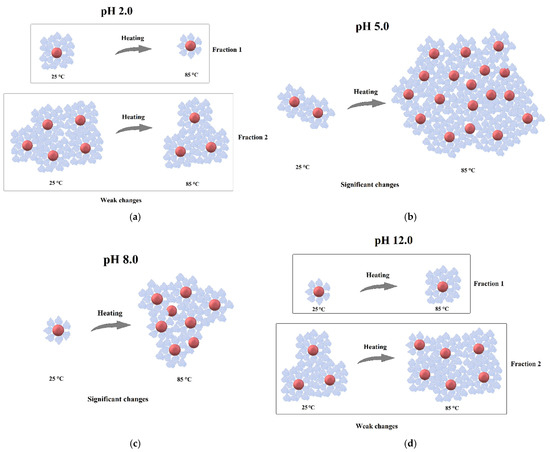
Figure 10.
Effect of temperature on the interaction of BSA with IONPs in aqueous colloid at pH (a) 2.0, (b) 5.0, (c) 8.0, (d) 12.0. At colloid pH 2.0 and 12.0, two fractions of particles with sizes from 10 nm and 100 nm were observed by DLS.
4. Conclusions
The article investigates the interaction of the BSA protein with IONPs with changes in pH and temperature. The conditions were found in which it is possible to change the size of aggregates, both IONPs and BSA + IONPs, using temperature and pH. The obtained results can be further used to obtain protein-nanoparticle systems of controlled size, which is often necessary in theranostics, in the manufacture of biosensors, gene/nutrient carriers, fertilizers, growth stimulants, in nanopriming technologies (treating seeds with nanoparticles), etc.
Author Contributions
Conceptualization, S.V.G.; methodology, R.M.S.; software, M.E.A.; validation, D.O.K., I.G.S., and M.B.R.; investigation, E.A.M., R.M.S., T.A.M., A.V.S., D.A.S., K.V.S., and M.A.S.; resources, A.G.A.; data curation, A.G.A.; writing—original draft preparation, E.A.M.; writing—review and editing, S.V.G., A.Y.I., and A.S.D.; visualization, E.A.M.; supervision, S.V.G.; funding acquisition, A.S.D. All authors have read and agreed to the published version of the manuscript.
Funding
This work was supported by a grant of the Ministry of Science and Higher Education of the Russian Federation for large scientific projects in priority areas of scientific and technological development (grant number 075-15-2024-540).
Data Availability Statement
The raw data supporting the conclusions of this article will be made available by the authors on request.
Conflicts of Interest
The authors declare no conflicts of interest.
Abbreviations
The following abbreviations are used in this manuscript:
| IONPs | Iron oxide nanoparticles |
| BSA | Bovine Serum Albumin |
| DLS | Dynamic light scattering |
Appendix A
Appendix A.1
Using the dynamic light scattering method, the number of light scattering particles in each size group of colloids containing only protein molecules, only nanoparticles, and both nanoparticles and protein molecules was estimated. It was shown that one ml contains about 1012 nanoparticles (Figure A1a) and 5 × 1015 protein molecules (Figure A1b). When mixing protein with nanoparticles, the colloid contains ~1013 particles (Figure A1c). Obviously, if nanoparticles did not interact with proteins, the number of particles would not change and would be about 5 × 1015 particles/mL. Additionally, if nanoparticles and proteins interact, the particle size should increase. If nanoparticles and proteins do not interact, the particle size will not change. It was shown that when mixing a colloid with nanoparticles and a colloid with proteins, particles larger than before appear (Figure A1d).
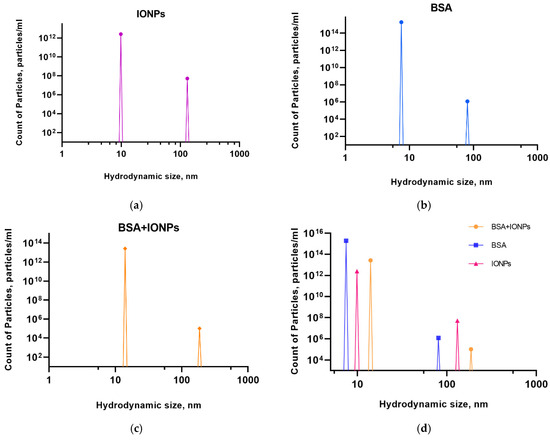
Figure A1.
Number of light diffusers of each size fraction (pH 5.0, 25 °C). (a) BSA, (b) IONPs, (c) BSA with IONPs, (d) BSA, IONPs, BSA with IONPs.
Appendix A.2
For ease of analysis of the data obtained by the DLS method, Figure A2 shows data on the average hydrodynamic diameter of the light diffusers with the smallest size. If several size groups of light diffusers were observed in the colloid, only the group with the smallest size was studied. This is due to the fact that aggregates consisting of a small number of BSA particles and/or iron oxide nanoparticles are the “building material” for larger aggregates, including submicron aggregates.
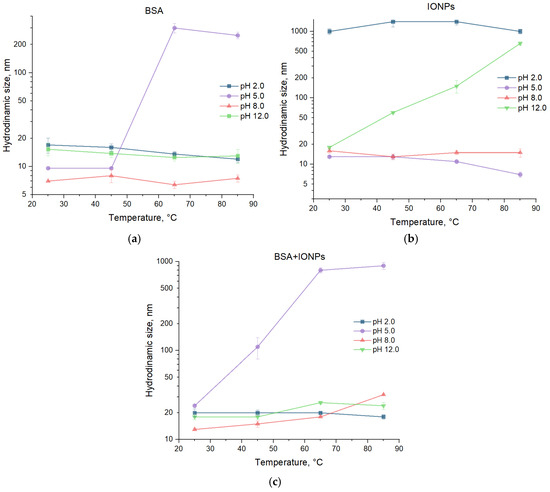
Figure A2.
Dependence of the average hydrodynamic diameter on temperature at different pH values 2–12 in colloidal solutions: (a) BSA, (b) IONPs, and (c) BSA with IONPs.
Appendix A.3
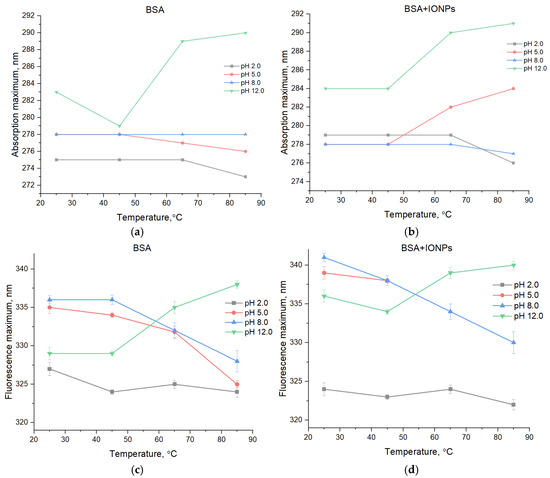
Figure A3.
Effect of temperature and pH on the spectroscopic characteristics of colloids containing only BSA molecules or BSA with iron oxide nanoparticles. Dependence of the absorption maximum on temperature at pH 2–12 for colloids: (a) BSA, (b) BSA with IONPs. Dependence of the fluorescence maximum on temperature at pH 2–12 for colloids: (c) BSA, (d) BSA with IONPs.
Appendix A.4
The effect of iron oxide nanoparticles on the secondary structure of BSA molecules was studied using the circular dichroism method (Figure A4, Table A1). It was shown that in the presence of nanoparticles, the secondary structure of BSA molecules changes by several percent. The most significant changes are observed at pH 2.0—about 3%.
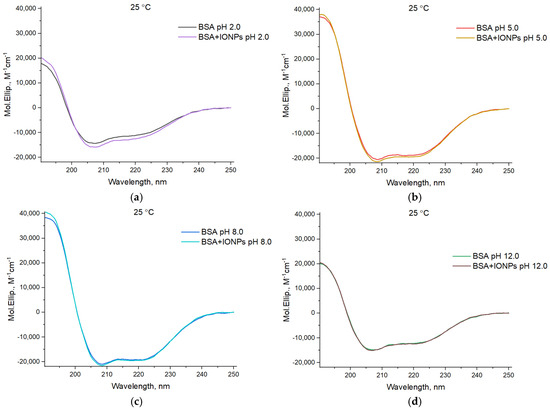
Figure A4.
Data obtained using the circular dichroism method. Comparison of the circular dichroism spectra of colloids containing only BSA and colloids containing BSA and nanoparticles at pH (a). 2.0, (b). 5.0, (c). 8.0, (d). 12.0.

Table A1.
This is a table caption.
Table A1.
This is a table caption.
| Samples | pH | α-Helix, % | Β-Sheet, % | Turn, % | Disorder, % |
|---|---|---|---|---|---|
| BSA | 2.0 | 32.9 | 15.1 | 21.8 | 30.3 |
| BSA + IONPs | 36.0 | 13.4 | 20.4 | 30.3 | |
| BSA | 5.0 | 54.1 | 5.6 | 14.2 | 26.1 |
| BSA + IONPs | 55.6 | 4.5 | 13.9 | 26.1 | |
| BSA | 8.0 | 55.8 | 5.0 | 13.4 | 25.9 |
| BSA + IONPs | 57.4 | 4.4 | 12.5 | 25.7 | |
| BSA | 12.0 | 36.4 | 12.4 | 20.6 | 30.6 |
| BSA + IONPs | 36.6 | 12.2 | 20.4 | 30.8 |
References
- Ahmed, I.; Mir, F.A.; Banday, J.A. Synthesis of metal and metal oxide nanoparticles using plant extracts—Characterization and applications. BioNanoScience 2023, 13, 1541–1557. [Google Scholar] [CrossRef]
- Tuttolomondo, M.V.; Municoy, S.; Echazú, M.I.A.; López, L.M.; Alvarez, G.S. Magnetic nanoparticles for nucleic acid delivery: Magnetofection, gene therapy and vaccines. Magn. Nanopart. Biomed. Appl 2023, 143, 278–313. [Google Scholar] [CrossRef]
- Khabibullin, V.R.; Chetyrkina, M.R.; Obydennyy, S.I.; Maksimov, S.V.; Stepanov, G.V.; Shtykov, S.N. Study on doxorubicin loading on differently functionalized iron oxide nanoparticles: Implications for controlled drug-delivery application. Int. J. Mol. Sci. 2023, 24, 4480. [Google Scholar] [CrossRef]
- Abdulsada, F.M.; Hussein, N.N.; Sulaiman, G.M. Potentials of Iron Oxide Nanoparticles (Fe3O4): As Antioxidant and Alternative Therapeutic Agent Against Common Multidrug-Resistant Microbial Species. Iraqi J. Sci. 2023, 64, 2759–2773. [Google Scholar] [CrossRef]
- Rahman, M. Magnetic resonance imaging and iron-oxide nanoparticles in the era of personalized medicine. Nanotheranostics 2023, 7, 424. [Google Scholar] [CrossRef]
- Ahmed, M.A.; Shafiei-Masouleh, S.-S.; Mohsin, R.M.; Salih, Z.K. Foliar application of iron oxide nanoparticles promotes growth, mineral contents, and medicinal qualities of Solidago virgaurea L. J. Soil Sci. Plant Nutr. 2023, 23, 2610–2624. [Google Scholar] [CrossRef] [PubMed]
- Shirsat, S.; K, S. Iron oxide nanoparticles as iron micronutrient fertilizer—Opportunities and limitations. J. Plant Nutr. Soil Sci. 2024, 187, 565–588. [Google Scholar] [CrossRef]
- Shoudho, K.N.; Uddin, S.; Rumon, M.M.H.; Shakil, M.S. Influence of physicochemical properties of iron oxide nanoparticles on their antibacterial activity. ACS Omega 2024, 9, 33303–33334. [Google Scholar] [CrossRef] [PubMed]
- Ventura-Aguilar, R.I.; Bautista-Baños, S.; Mendoza-Acevedo, S.; Bosquez-Molina, E. Nanomaterials for designing biosensors to detect fungi and bacteria related to food safety of agricultural products. Postharvest Biol. Technol. 2023, 195, 112116. [Google Scholar] [CrossRef]
- Garg, S.; Rumjit, N.P.; Roy, S. Smart agriculture and nanotechnology: Technology, challenges, and new perspective. Adv. Agrochem 2024, 3, 115–125. [Google Scholar] [CrossRef]
- Francis, D.V.; Abdalla, A.K.; Mahakham, W.; Sarmah, A.K.; Ahmed, Z.F. Interaction of plants and metal nanoparticles: Exploring its molecular mechanisms for sustainable agriculture and crop improvement. Environ. Int. 2024, 190, 108859. [Google Scholar] [CrossRef] [PubMed]
- Santás-Miguel, V.; Arias-Estévez, M.; Rodríguez-Seijo, A.; Arenas-Lago, D. Use of metal nanoparticles in agriculture. A review on the effects on plant germination. Environ. Pollut. 2023, 334, 122222. [Google Scholar] [CrossRef]
- Gudkov, S.V.; Sarimov, R.M.; Astashev, M.E.; Pishchalnikov, R.Y.; Yanykin, D.V.; Simakin, A.V.; Shkirin, A.V.; Serov, D.A.; Konchekov, E.M.; Ogly, G. Modern physical methods and technologies in agriculture. Phys. Uspekhi 2024, 67, 194–210. [Google Scholar] [CrossRef]
- Serov, D.A.; Burmistrov, D.E.; Simakin, A.V.; Astashev, M.E.; Uvarov, O.V.; Tolordava, E.R.; Semenova, A.A.; Lisitsyn, A.B.; Gudkov, S.V. Composite coating for the food industry based on fluoroplast and ZnO-NPs: Physical and chemical properties, antibacterial and antibiofilm activity, cytotoxicity. Nanomaterials 2022, 12, 4158. [Google Scholar] [CrossRef]
- Góral, D.; Marczuk, A.; Góral-Kowalczyk, M.; Koval, I.; Andrejko, D. Application of iron nanoparticle-based materials in the food industry. Materials 2023, 16, 780. [Google Scholar] [CrossRef]
- Misra, S.K.; Rosenholm, J.M.; Pathak, K. Functionalized and Nonfunctionalized Nanosystems for Mitochondrial Drug Delivery with Metallic Nanoparticles. Molecules 2023, 28, 4701. [Google Scholar] [CrossRef] [PubMed]
- Sharma, K.; Chauhan, C. Role of magnetic nanoparticle (MNPs) in cancer treatment: A review. Mater. Today Proc. 2023, 81, 919–925. [Google Scholar] [CrossRef]
- Qiao, R.; Fu, C.; Forgham, H.; Javed, I.; Huang, X.; Zhu, J.; Whittaker, A.K.; Davis, T.P. Magnetic iron oxide nanoparticles for brain imaging and drug delivery. Adv. Drug Deliv. Rev. 2023, 197, 114822. [Google Scholar] [CrossRef] [PubMed]
- Oberdick, S.D.; Jordanova, K.V.; Lundstrom, J.T.; Parigi, G.; Poorman, M.E.; Zabow, G.; Keenan, K.E. Iron oxide nanoparticles as positive T1 contrast agents for low-field magnetic resonance imaging at 64 mT. Sci. Rep. 2023, 13, 11520. [Google Scholar] [CrossRef]
- Vangijzegem, T.; Lecomte, V.; Ternad, I.; Leuven, L.V.; Muller, R.N.; Stanicki, D.; Laurent, S. Superparamagnetic iron oxide nanoparticles (SPION): From fundamentals to state-of-the-art innovative applications for cancer therapy. Pharmaceutics 2023, 15, 236. [Google Scholar] [CrossRef]
- Hernandes, E.P.; Lazarin-Bidóia, D.; Bini, R.D.; Nakamura, C.V.; Cótica, L.F.; de Oliveira Silva Lautenschlager, S. Doxorubicin-loaded iron oxide nanoparticles induce oxidative stress and cell cycle arrest in breast cancer cells. Antioxidants 2023, 12, 237. [Google Scholar] [CrossRef] [PubMed]
- Rivas-García, L.; Quiles, J.L.; Varela-López, A.; Giampieri, F.; Battino, M.; Bettmer, J.; Montes-Bayón, M.; Llopis, J.; Sánchez-González, C. Ultra-small iron nanoparticles target mitochondria inducing autophagy, acting on mitochondrial dna and reducing respiration. Pharmaceutics 2021, 13, 90. [Google Scholar] [CrossRef]
- Zafar, S.; Farooq, A.; Batool, S.; Tariq, T.; Hasan, M.; Mustafa, G. Green synthesis of iron oxide nanoparticles for mitigation of chromium stress and anti-oxidative potential in Triticum aestivum. Hybrid Adv. 2024, 5, 100156. [Google Scholar] [CrossRef]
- Kreslavski, V.D.; Shmarev, A.N.; Ivanov, A.A.; Zharmukhamedov, S.K.; Strokina, V.; Kosobryukhov, A.; Yu, M.; Allakhverdiev, S.I.; Shabala, S. Effects of iron oxide nanoparticles (Fe3O4) and salinity on growth, photosynthesis, antioxidant activity and distribution of mineral elements in wheat (Triticum aestivum). Funct. Plant Biol. 2023, 50, 932–940. [Google Scholar] [CrossRef] [PubMed]
- Ghouri, F.; Sarwar, S.; Sun, L.; Riaz, M.; Haider, F.U.; Ashraf, H.; Lai, M.; Imran, M.; Liu, J.; Ali, S. Silicon and iron nanoparticles protect rice against lead (Pb) stress by improving oxidative tolerance and minimizing Pb uptake. Sci. Rep. 2024, 14, 5986. [Google Scholar] [CrossRef]
- Kim, W.; Ly, N.K.; He, Y.; Li, Y.; Yuan, Z.; Yeo, Y. Protein corona: Friend or foe? Co-opting serum proteins for nanoparticle delivery. Adv. Drug Deliv. Rev. 2023, 192, 114635. [Google Scholar] [CrossRef]
- Le, T.-D.; Suttikhana, I.; Ashaolu, T.J. State of the art on the separation and purification of proteins by magnetic nanoparticles. J. Nanobiotechnol. 2023, 21, 363. [Google Scholar] [CrossRef]
- Turovsky, E.A.; Baryshev, A.S.; Plotnikov, E.Y. Selenium nanoparticles in protecting the brain from stroke: Possible signaling and metabolic mechanisms. Nanomaterials 2024, 14, 160. [Google Scholar] [CrossRef]
- Shan, H.; Zhao, Q.; Guo, Y.; Gao, M.; Xu, X.; McClements, D.J.; Cao, C.; Yuan, B. Impact of pH on the formation and properties of whey protein coronas around TiO2 nanoparticles. J. Agric. Food Chem. 2023, 71, 5756–5769. [Google Scholar] [CrossRef]
- Tukova, A.; Nie, Y.; Tavakkoli Yaraki, M.; Tran, N.T.; Wang, J.; Rodger, A.; Gu, Y.; Wang, Y. Shape dependent protein-induced stabilization of gold nanoparticles: From a protein corona perspective: Special Collection: Distinguished Australian Researchers. Aggregate 2023, 4, e323. [Google Scholar] [CrossRef]
- Astashev, M.; Serov, D.; Sarimov, R.; Gudkov, S. Influence of the Vibration Impact Mode on the Spontaneous Chemiluminescence of Aqueous Protein Solutions. Phys. Wave Phenom. 2023, 31, 189–199. [Google Scholar] [CrossRef]
- Paukštytė, J.; Cabezas, R.M.L.; Feng, Y.; Tong, K.; Schnyder, D.; Elomaa, E.; Gregorova, P.; Doudin, M.; Särkkä, M.; Sarameri, J. Global analysis of aging-related protein structural changes uncovers enzyme-polymerization-based control of longevity. Mol. Cell 2023, 83, 3360–3376. [Google Scholar] [CrossRef]
- Xu, Q.; Ma, Y.; Sun, Y.; Li, D.; Zhang, X.; Liu, C. Protein amyloid aggregate: Structure and function. Aggregate 2023, 4, e333. [Google Scholar] [CrossRef]
- Wang, W.; Huang, Z.; Li, Y.; Wang, W.; Shi, J.; Fu, F.; Huang, Y.; Pan, X.; Wu, C. Impact of particle size and pH on protein corona formation of solid lipid nanoparticles: A proof-of-concept study. Acta Pharm. Sin. B 2021, 11, 1030–1046. [Google Scholar] [CrossRef] [PubMed]
- Resende, L.F.T.; Basilio, F.C.; Filho, P.A.; Therézio, E.M.; Silva, R.A.; Oliveira, O.N., Jr.; Marletta, A.; Campana, P.T. Revisiting the conformational transition model for the pH dependence of BSA structure using photoluminescence, circular dichroism, and ellipsometric Raman spectroscopy. Int. J. Biol. Macromol. 2024, 259, 129142. [Google Scholar] [CrossRef]
- Sajib, M.; Forghani, B.; Vate, N.K.; Abdollahi, M. Combined effects of isolation temperature and pH on functionality and beany flavor of pea protein isolates for meat analogue applications. Food Chem. 2023, 412, 135585. [Google Scholar] [CrossRef] [PubMed]
- Mahmoudi, M.; Landry, M.P.; Moore, A.; Coreas, R. The protein corona from nanomedicine to environmental science. Nat. Rev. Mater. 2023, 87, 422. [Google Scholar] [CrossRef]
- Liu, W.; Rose, J.; Plantevin, S.; Auffan, M.; Bottero, J.Y.; Vidaud, C. Protein corona formation for nanomaterials and proteins of a similar size: Hard or soft corona? Nanoscale 2013, 5, 1658. [Google Scholar] [CrossRef]
- Mahmoudi, M.; Kalhor, H.R.; Laurent, S.; Lynch, I. Protein fibrillation and nanoparticle interactions: Opportunities and challenges. Nanoscale 2013, 5, 2570. [Google Scholar] [CrossRef]
- Sarimov, R.M.; Nagaev, E.I.; Matveyeva, T.A.; Binhi, V.N.; Burmistrov, D.E.; Serov, D.A.; Astashev, M.E.; Simakin, A.V.; Uvarov, O.V.; Khabatova, V.V.; et al. Investigation of Aggregation and Disaggregation of Self-Assembling Nano-Sized Clusters Consisting of Individual Iron Oxide Nanoparticles upon Interaction with HEWL Protein Molecules. Nanomaterials 2022, 12, 3960. [Google Scholar] [CrossRef]
- Akopdzhanov, A.G.; Shimanovskii, N.L.; Borisova, A.I.; Parshin, V.A.; Frolov, G.A. Magnetic Ferrite Nanoparticles as a Possible Platform for Magnetic-Resonance Contrast Agents. Pharm. Chem. J. 2020, 53, 1164. [Google Scholar] [CrossRef]
- Park, J.H.; Sut, T.N.; Jackman, J.A.; Ferhan, A.R.; Yoon, B.K.; Cho, N.J. Controlling adsorption and passivation properties of bovine serum albumin on silica surfaces by ionic strength modulation and cross-linking. Phys. Chem. Chem. Phys. 2017, 19, 8854. [Google Scholar] [CrossRef]
- Shkirin, A.; Suyazov, N.; Chirikov, S.; Chaikov, L.; Shermeneva, M.; Gudkov, S. Features of light scattering in turbid media as modeled for two-component emulsions. Phys. Wave Phenom. 2024, 32, 280–289. [Google Scholar] [CrossRef]
- Molkova, E.; Pustovoi, V.; Baimler, I.; Simakin, A.; Burmistrov, D.; Gorudko, I.; Gudkov, S. Optical Study of the Influence of the Medium Acidity on the Interaction between Gold Nanoparticles and Bovine Serum Albumin in Aqueous Solution. Phys. Wave Phenom. 2024, 32, 232–240. [Google Scholar] [CrossRef]
- Alzoubi, F.; Noqta, O.; AlZoubi, T.; AlJabaly, H.; Alkhateeb, H.; Alqadi, M.; Makhadmeh, G. Exploring the impact of pH on the properties of citric acid-coated iron oxide nanoparticles as high-performance T2 contrast agent for MRI applications. Results Eng. 2023, 18, 101206. [Google Scholar] [CrossRef]
- Serrano-Lotina, A.; Portela, R.; Baeza, P.; Alcolea-Rodríguez, V.; Villarroel, M.; Ávila, P. Zeta potential as a tool for functional materials development. Catal. Today 2023, 423, 113862. [Google Scholar] [CrossRef]
- Kosmulski, M. The pH dependent surface charging and points of zero charge. X. Update. Adv. Colloid Interface Sci. 2023, 319, 102973. [Google Scholar] [CrossRef]
- Li, J.; Li, L. Preparation of a novel nanoparticle with extruded soy protein isolate-oat β-glucan: Interfacial properties and mechanism of emulsion stability. Food Hydrocoll. 2024, 150, 109686. [Google Scholar] [CrossRef]
- García-Acevedo, P.; González-Gómez, M.A.; Arnosa-Prieto, Á.; de Castro-Alves, L.; Piñeiro, Y.; Rivas, J. Role of dipolar interactions on the determination of the effective magnetic anisotropy in iron oxide nanoparticles. Adv. Sci. 2023, 10, 2203397. [Google Scholar] [CrossRef]
- Zhang, W.; Zhang, Y.; He, Y.; Xu, X.; Zhao, X. Oil density and viscosity affect emulsion stability and destabilization mechanism. J. Food Eng. 2024, 366, 111864. [Google Scholar] [CrossRef]
- Rodríguez-Calderón, A.G.; Núñez-Anita, R.E.; Holguín-Momaca, J.T.; Contreras-García, M.E. Constructing Noncytotoxic Organometallic Nanostructures of Ag–BSA–CaCO3. Appl. Organomet. Chem. 2024, 38, e7745. [Google Scholar] [CrossRef]
- Esfandiary, R.; Middaugh, C.R. Ultraviolet absorption spectroscopy. In Analysis of Aggregates and Particles in Protein Pharmaceuticals; Wiley: Hoboken, NJ, USA, 2012; p. 169. [Google Scholar] [CrossRef]
- Sarimov, R.M.; Matveyeva, T.A.; Binhi, V.N. Laser interferometry of the hydrolytic changes in protein solutions: The refractive index and hydration shells. J. Biol. Phys. 2018, 44, 345. [Google Scholar] [CrossRef] [PubMed]
- Bag, S.; Mitra, R.; DasGupta, S.; Dasgupta, S. Inhibition of Human Serum Albumin Fibrillation by Two-Dimensional Nanoparticles. J. Phys. Chem. B 2017, 121, 5474. [Google Scholar] [CrossRef]
- Nan, Z.; Hao, C.; Ye, X.; Feng, Y.; Sun, R. Interaction of graphene oxide with bovine serum albumin: A fluorescence quenching study. Spectrochim. Acta Part A Mol. Biomol. Spectrosc. 2019, 210, 348. [Google Scholar] [CrossRef]
- Wang, Y.; Xie, Y.; Li, T.; Wang, Y.; Jiang, J.; Zhang, X.; Xia, B.; Wang, S.; Huang, J.; Dong, W. Pickering emulsions with high ionic strength resistance stabilized by pea protein isolate-polyglycerol conjugate particles with good biocompatibility. Int. J. Biol. Macromol. 2024, 269, 131797. [Google Scholar] [CrossRef]
- Shahabadi, N.; Zendehcheshm, S.; Mahdavi, M. Exploring the In-Vitro Antibacterial Activity and Protein (Human Serum Albumin, Human Hemoglobin and Lysozyme) Interaction of Hexagonal Silver Nanoparticle Obtained from Wood Extract of Wild Cherry Shrub. ChemistrySelect 2023, 8, e202204672. [Google Scholar] [CrossRef]
- Khan, S.; Cho, W.C.; Hussain, A.; Azimi, S.; Babadaei, M.M.N.; Bloukh, S.H.; Edis, Z.; Saeed, M.; Hagen, T.L.T.; Ahmadi, H. The interaction mechanism of plasma iron transport protein transferrin with nanoparticles. Int. J. Biol. Macromol. 2023, 240, 124441. [Google Scholar] [CrossRef]
- Honcharova, O.; Dmytrenko, O.; Lesiuk, A.; Kulish, M.; Pavlenko, O.; Naumenko, A.; Doroshenko, I.Y.; Zholobak, N.; Kaniuk, M. Binding parameters and conjugation mechanisms in the solutions of BSA with antioxidant CeO2 nanoparticles. Mol. Cryst. Liq. Cryst. 2023, 750, 144–154. [Google Scholar] [CrossRef]
Disclaimer/Publisher’s Note: The statements, opinions and data contained in all publications are solely those of the individual author(s) and contributor(s) and not of MDPI and/or the editor(s). MDPI and/or the editor(s) disclaim responsibility for any injury to people or property resulting from any ideas, methods, instructions or products referred to in the content. |
© 2025 by the authors. Licensee MDPI, Basel, Switzerland. This article is an open access article distributed under the terms and conditions of the Creative Commons Attribution (CC BY) license (https://creativecommons.org/licenses/by/4.0/).